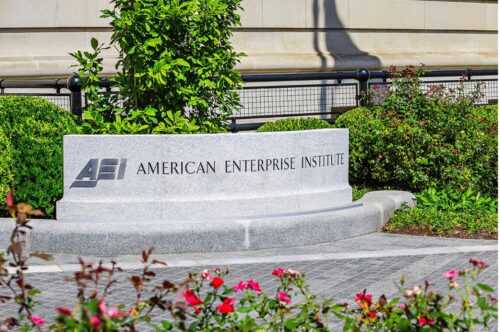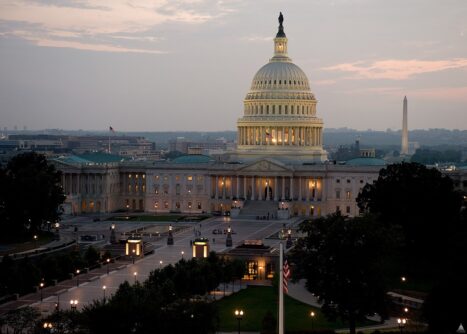In Milwaukee, it didn’t start with any grantmaker. The indispensable groundwork was laid by parents concerned about the education of their children.
This article originally appeared in HistPhil, as part of a forum on education and philanthropy, on October 5, 2015.
One thing upon which friends and foes of school choice agree: without the Lynde and Harry Bradley Foundation, the initial education voucher experiment in Milwaukee would never have occurred.
As fierce voucher opponent People for the American Way put it in 2003, quoting a state superintendent of instruction, “the program would never have started if it were not for Michael Joyce, president of the Bradley Foundation until 2001. … Without them, we wouldn’t have school vouchers.” In its recently published monograph Agenda Setting: A Wise Giver’s Guide to Influencing Public Policy, voucher friend Philanthropy Roundtable noted that “the [Bradley] Foundation was indispensable to transforming school choice from mere concept to active movement …. If the reform effort continues to expand, it will be due almost entirely to philanthropists who have been willing to invest for the long haul.”
But school choice friends and foes are dead wrong about this—an error of more than mere historical interest, because so much of philanthropic practice today rests on this misconception.
In fact, well before the Bradley Foundation was established in 1985, Milwaukee had already witnessed the rise of a powerful movement among African Americans and Hispanics to establish independent, community-based schools, and to secure public funding for them through vouchers.
Community remedies
After Milwaukee’s African American community had expanded tremendously in the 1950s during the “Second Great Migration,” it found itself saddled with public schools that were woefully inadequate: segregated, antiquated, and staffed by indifferent teachers. To remedy this, community leaders founded several of their own private schools like Harambee and Urban Day, which sought to cultivate pride as well as accomplishment through their Afrocentric curricula.
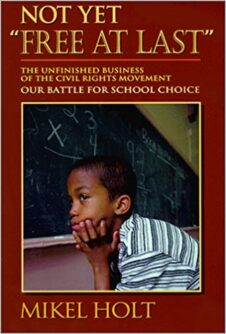 As Harambee parent and school choice activist Mikel Holt put it in his insider account Not Yet “Free At Last”: Our Battle for School Choice, students at these schools “are given a sense of self-actualization—Black pride if you will—and are told they are keepers of the flame. They are told that their ancestors didn’t mysteriously appear on Earth as slaves, but were creators of science and math and the arts.” The southside Hispanic community similarly tapped into an inspiriting ethnicity through its own Bruce Guadalupe school. As the Catholic Church began to close its schools in the central city, more independent schools sprang up in their former buildings, reflecting the values of a variety of religious and ethnic communities.
As Harambee parent and school choice activist Mikel Holt put it in his insider account Not Yet “Free At Last”: Our Battle for School Choice, students at these schools “are given a sense of self-actualization—Black pride if you will—and are told they are keepers of the flame. They are told that their ancestors didn’t mysteriously appear on Earth as slaves, but were creators of science and math and the arts.” The southside Hispanic community similarly tapped into an inspiriting ethnicity through its own Bruce Guadalupe school. As the Catholic Church began to close its schools in the central city, more independent schools sprang up in their former buildings, reflecting the values of a variety of religious and ethnic communities.
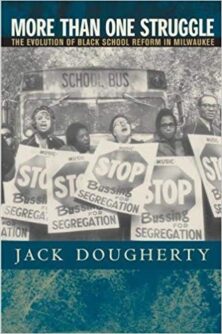 Indeed, as Jack Dougherty notes in his indispensable More than One Struggle: the Evolution of Black School Reform in Milwaukee, by 1970 ten or so independent schools educating 2,000 children had banded together into the Federation of Independent Community Schools. Moreover, they had responded eagerly to the federal Office of Economic Opportunity’s (OEO’s) announcement of funding for a one-city voucher experiment. Robert O. Bothwell—then at the Center for the Study of Public Policy in Cambridge, but later director of voucher skeptic National Committee for Responsive Philanthropy—made several trips to the city under OEO auspices to encourage the application. “‘We’ve been interested in Milwaukee from the very beginning,’ Bothwell told an audience at the predominantly black Northside YMCA,” according to Dougherty. “‘Milwaukee already has ten independent schools which are new and prime to implement new programs.’” The required sponsorship by the public school board was not forthcoming, however, beginning several decades of entrenched opposition to voucher experiments.
Indeed, as Jack Dougherty notes in his indispensable More than One Struggle: the Evolution of Black School Reform in Milwaukee, by 1970 ten or so independent schools educating 2,000 children had banded together into the Federation of Independent Community Schools. Moreover, they had responded eagerly to the federal Office of Economic Opportunity’s (OEO’s) announcement of funding for a one-city voucher experiment. Robert O. Bothwell—then at the Center for the Study of Public Policy in Cambridge, but later director of voucher skeptic National Committee for Responsive Philanthropy—made several trips to the city under OEO auspices to encourage the application. “‘We’ve been interested in Milwaukee from the very beginning,’ Bothwell told an audience at the predominantly black Northside YMCA,” according to Dougherty. “‘Milwaukee already has ten independent schools which are new and prime to implement new programs.’” The required sponsorship by the public school board was not forthcoming, however, beginning several decades of entrenched opposition to voucher experiments.
After court-ordered busing failed to bring notable improvement to inner city education, and building on the experience of running their own independent schools, the Black community on Milwaukee’s north side resolved in 1987 to establish its own school district, centered around North Division High School, from which many of its leaders had emerged. In his first campaign for governor, Republican Tommy Thompson actually supported this measure, but, as Holt noted, “with the condition that such a plan would have to come from the Black community—not from Republican leadership.” Although the school board, the teachers’ union, and the NAACP all fiercely opposed the proposal, its sponsor, Black State Rep. Annette “Polly” Williams, denounced them for failing to “give us a chance to educate our own.”
By 1990, Williams and Thompson had concluded that the best way to allow Milwaukee’s neighborhoods to “educate their own” was through a system of vouchers. The voucher bill that finally passed that year—the first in the nation—was limited to a handful of non-sectarian schools like Harambee, Urban Day, and Bruce Guadalupe. But by 1995, with strong support from Democrat Mayor John Norquist as well as Williams and Thompson, vouchers were extended to Milwaukee’s sectarian schools as well, which included a rich mix of Catholic, Baptist, Pentecostal, Orthodox Jewish, and Muslim schools. (Lutheran schools initially hesitated to join, but did so later.)
Determination and drive
Note that we’ve managed to describe the “program that would never have started if it were not for Michael Joyce” without mentioning Michael Joyce. Likewise, Dougherty’s More Than One Struggle documents four decades of education reform in Milwaukee, attributing it to the interplay between Black commitments to racial integration, on the one hand, and community self-determination, on the other, with only passing references to Bradley’s bit part in the concluding phase of this drama.
That’s because the indispensable groundwork for the choice movement had been laid some two decades before the foundation was even established in 1985. More to the point, it had absolutely nothing to do with conservative ideology, and everything to do with the determination of Milwaukee’s Black and Hispanic communities to provide the sort of education for their children that the public schools had so conspicuously failed to deliver.
This is not to say that Joyce and the foundation had no role to play as school choice secured a foothold and grew. The foundation supported advocacy nonprofits, helped fund the successful legal defense of the program before the Wisconsin Supreme Court, and provided substantial dollars for the schools themselves, through a private voucher program plus individual grants. Holt notes, “without the Bradley Foundation the uphill climb would have been much steeper.” But he also insists that “the Foundation was never involved in the planning, coordination or leadership of the movement; its assistance was neither sought nor required.” This was true, as far as I could tell from my time at the foundation, from 1992 to 2001.
Indeed, in his handling of the foundation’s involvement with school choice, Michael Joyce himself was extremely careful to take his cues from the movement’s pre-established leadership. He deliberately and consistently refused to describe Bradley’s support for vouchers in terms of the advantages of marketplace competition, the economic argument so prized by Milton Friedman libertarians. Rather, he insisted that vouchers would help strengthen inner city families, neighborhoods, and ethnic and voluntary communities, drawing upon the language and vision of Milwaukee’s neighborhood leaders.
To be sure, Joyce was predisposed to this by his own upbringing in Cleveland’s tough, vigorous, blue collar Catholic neighborhoods, which embodied the church’s notion of “subsidiarity,” or solving problems in as local and decentralized a fashion as possible. Joyce would make this part of the foundation’s purpose, calling for a “new citizenship” that would shift power away from centralized government back to revitalized local religious, ethnic, and voluntary associations. Again, this went well beyond conservatism’s customary orientation toward business interests and free enterprise, and looked to the reinvigoration of American civil society—even when it took forms, like Holt’s and Williams’ Afrocentrism, that would make most conservatives distinctly uncomfortable. The critical point is that the Bradley Foundation’s full-throated commitment to civic renewal was more driven by than driving the movement for school choice.
Parents, not a plot
The myth of school choice springing full-grown from Bradley’s brow arose early on because its detractors, of course, found it far easier to dismiss vouchers as a conservative plot than to deal with the conspicuously non-conservative but determined and desperate minority parents who in fact were behind school choice. Indeed, whatever support Bradley supplied must be discounted against the endless stream of conspiracy theories about school choice’s hidden right-wing agenda that dogged even the most non-conservative choice advocates. And that is to say nothing of the massive tide of hostile dollars, media attention, and seasoned organizers choice advocates faced, as local, state, and national teachers unions, the NAACP, ACLU, and People for the American Way were all drawn into Milwaukee by what they regarded as an ideological showdown signaled by Bradley’s presence.
In the 90s, a minor publishing industry arose around the analysis of conservative philanthropic successes, among which school choice figured prominently. Occasionally animated by admiration rather than hostility, such accounts attributed the success of school choice to Bradley’s focus, determination, long-term commitment, and flexible funding through loosely structured (that is to say, unmeasured) general operating support. These characteristics were indeed important, but many failed to see that they reflected the foundation’s determination to follow, rather than to lead. They were qualities needed to seek out, slowly gain the trust of, and prove resolute allies to scrappy, controversial, “management-challenged” grassroots groups. The foundation never attempted to impose an agenda on the movement, which would only have alienated groups that had become all too accustomed to fair weather friends, and would have immediately nullified the authority fiercely independent choice leaders had earned within the community. This often meant swallowing hard when choice schools embraced pedagogies condemned by conservative education experts. But nothing less was required to live up to foundation’s own injunction to trust the judgment of parents over that of outside experts and bureaucrats.
As the new century began, however, admirers of philanthropic focus and determination severed the attachment to grassroots leadership so important to Bradley. Why leave outcomes up to the unpredictable actions of scruffy, politically incompatible grassroots rebels, when we can import business management techniques that guarantee results? So the new “strategic philanthropy” called for foundation-defined objectives imposed from above, executed according to detailed logic models, with precisely measurable outcomes to be delivered by reliably subservient nonprofits on a rigorous timetable. Bradley’s success had been misinterpreted, attributed to a rigid and unyielding imposition of its own self-selected goals, rather than its determination to follow rather than lead, listen rather than dictate, begin at the bottom rather than at the top.
The genuine source of success
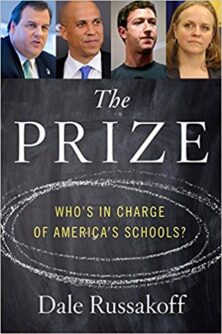 What happens when the misconstrued lessons of Milwaukee education reform meet the real world? That’s the story of Dale Russakoff’s new book The Prize: Who’s in Charge of America’s Schools? It is a withering critique of big philanthropy’s effort to reform the Newark school system. As she notes, Facebook founder Mark Zuckerberg’s commitment of $100 million, to be matched dollar for dollar by other philanthropists, brought to Newark the full panoply of techniques championed by strategic philanthropy. The effort was driven from above by a comprehensive collaboration of politicians, foundation executives and well-compensated consultants, strapped into a rigid metrics framework, and animated by the blustery, puerile, self-important jargon of the contemporary B-school.
What happens when the misconstrued lessons of Milwaukee education reform meet the real world? That’s the story of Dale Russakoff’s new book The Prize: Who’s in Charge of America’s Schools? It is a withering critique of big philanthropy’s effort to reform the Newark school system. As she notes, Facebook founder Mark Zuckerberg’s commitment of $100 million, to be matched dollar for dollar by other philanthropists, brought to Newark the full panoply of techniques championed by strategic philanthropy. The effort was driven from above by a comprehensive collaboration of politicians, foundation executives and well-compensated consultants, strapped into a rigid metrics framework, and animated by the blustery, puerile, self-important jargon of the contemporary B-school.
In spite of the fact that, as Russakoff reports, a number of Newark teachers and schools were putting together thoughtful, nuanced, responsive, and locally appropriate reform efforts that could have flourished with mere crumbs from the philanthropic table, no effort was made to locate or support them. Instead, “for four years, the reformers never really tried to have a conversation with the people of Newark. Their target audience was always somewhere else, beyond the people whose children and grandchildren desperately needed to learn and compete for a future.”
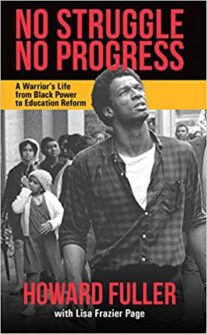 Without any footing in promising local efforts to bring about their own, self-defined reforms, the $200 million effort glanced off the Newark education colossus, and limped out of town with very little to show for it. The explanation for this was readily apparent to Milwaukee school choice veteran and national education reformer Howard Fuller, who came through Newark in 2014, promoting his powerful autobiography No Struggle No Progress: A Warrior’s Life from Black Power to Education Reform. (As the title suggests, Fuller, like Williams and Holt, was no conservative free market lackey, though benefitting from Bradley funding over the years.)
Without any footing in promising local efforts to bring about their own, self-defined reforms, the $200 million effort glanced off the Newark education colossus, and limped out of town with very little to show for it. The explanation for this was readily apparent to Milwaukee school choice veteran and national education reformer Howard Fuller, who came through Newark in 2014, promoting his powerful autobiography No Struggle No Progress: A Warrior’s Life from Black Power to Education Reform. (As the title suggests, Fuller, like Williams and Holt, was no conservative free market lackey, though benefitting from Bradley funding over the years.)
No doubt recalling the very different approach taken by Bradley in Milwaukee, Fuller noted that
a lot of us education reformers—and I include myself—have been too arrogant. … It’s not even what you do sometimes, it’s the way you treat people in the process of doing it. … Why do you think you can just get [a lot of smart people] in a room and make decisions for a community of people?
Why indeed? In some measure because philanthropy had learned the wrong lesson from education reform in Milwaukee. It concluded erroneously that Bradley’s singular focus and drive were the source of success, needing only to be turbocharged by rigorous management methodologies to tackle larger challenges like Newark. Overlooked was the genuine source of success, Bradley’s willingness to put aside rigid ideological preferences in order to support whatever decisions parents made about their own children’s education, aiming thereby to help reinvigorate the local civic and educational institutions that are the backbone of vital neighborhoods.




